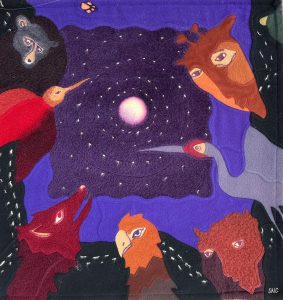The final stage or conflict (or state of mind or life theme) in life is integrity vs. despair. As with so much else in a person’s life, these states of mind are not necessarily clear-cut. I think what we want to do is incline ourselves toward integrity vs. inclining toward despair or kind of drifting along with under-lying despair. How does that happen?
I believe it’s true that we’re generally doing the best we can under the circumstances. Most of us could sometimes do better, but still, looking back, not bad.
It’s not about accomplishments in the common use of that concept. For some people it’s a great, great accomplishment to be a half-way decent person – to not be abusive or mean. I mean, wouldn’t it be a beautiful world if everybody was non-abusive, not mean, not a cheater! So yes, good work, mate!
One way to move toward positive resolution (integrity or integration) is to deepen one’s life review. I say “deepen” because most people do think about their life, even when they try not to think about it. Too often we focus on negatives, losses, mistakes, failures, bad things beyond our control (like a hard childhood or poverty or death), and stay stuck on those parts or even pretend that they don’t exist. But they do. How does one get past failures or lacks in life? Here we go with one conception of the deepened life review.
(Life review is a psychological, emotional, social, and ultimately spiritual process of exploring one’s life past and present, how it unfolded, choices made, relationships, losses, patterns, themes, values, and other core dimensions of a life.)
One way to review in a holistic way is think about in detail 5-8 things in each of the below categories:
- What is missing in life now (people, activities, abilities).
- Wonderful things that have happened.
- Regrets and mistakes and bad things that happened, including those we had no control over.
- Hard times and getting through them.
- Good moves/accomplishments.
Looking closely at these, we can see that there may much to grieve, there may be things that have wounded us, things that have wounded others, things that are hard to see and accept, things that were and were not our fault. It is my firm belief that going deep into the negatives is necessary to really see the positives – the beautiful things, the life accomplishments, the strengths, the beauty in not being mean.
There are other life review processes. My focus is on words, but of course there are other means of expression such as art, music, and other ways of self-expression. Many include recommendations to do it as part formal group or with professional guidance. That’s not necessary. Google or ChatGPT will yield several structures for doing one’s own life review.
Life review processes or techniques include:
- Mapping time, e.g., a history of life (key events, motivators, people, emotions, decisions, stressors, etc.)
- Taking a deep dive into turning points and thresholds (what was life like before and after and after the change, what inner and outer resources were involved, what was left behind and gained, and what issues still linger).
- Writing letters to my younger self at three specific ages/turning points.
- Writing four to five “stories that made me who I am today,” including lessons learned.
- These are directed toward integration vs. nostalgia.
It is a worthy thing to do is write one’s obituary, eulogy, or things you would like to be remembered for after you die.
This is written with the idea that some readers might consider this for themselves. Any age is a good time to do it. Old age is an especially good time to do it.
Background: Based on experience and other explorations of life and death I developed training for staff in the first hospice in Texas. Training included values clarification and life review for everyone who would be working in hospice (originally called the “obituary exercise”). The idea was to increase self-awareness and thus increase understanding and empathy around this major life event – the end of a life. Every training, class, or workshop included a lot of content on the practicalities of physical care at the end of life. Variations on the initial training continued in the original hospice, other hospice programs, workshops, and into undergraduate and graduate courses on the end of life. I also taught values clarification and life review as tools to use in working with patients and families facing the end of life.
We were at a friend’s home, talking. My friend said, “I haven’t really accomplished much in life.” I looked around and thought, “What a beautiful home and life you’ve created. Actually (I thought) you’re a truly beautiful person.”


